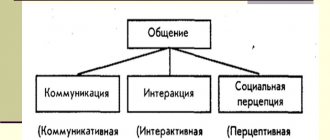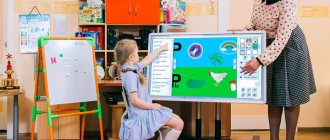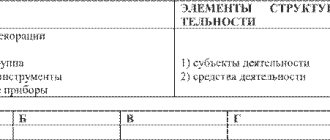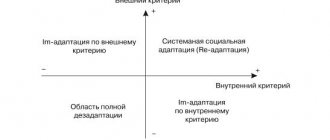Styles of pedagogical communication
The factors influencing the development of a student’s personality are styles of pedagogical communication.
The style of pedagogical communication and leadership is determined by the techniques and methods of educational influence, which are manifested in a set of expectations and requirements for the appropriate behavior of students. Style is embodied in the forms of organizing activities, as well as communication between children, having certain ways of implementing relationships with children. Traditionally, authoritarian, democratic and liberal styles of pedagogical communication are distinguished.
Democratic style of pedagogical communication
The most effective and optimal is the democratic style of interaction. It is marked by a characteristic broad contact with students, a manifestation of respect and trust, in which the teacher tries to establish emotional interaction with the child and does not suppress the personality with punishment and severity; Communication with children is rated positively.
A democratic teacher needs feedback from students, namely, how they perceive forms of joint activity and whether they know how to admit their mistakes. The work of such a teacher is aimed at stimulating mental activity and motivation in achieving cognitive activity. In groups of educators, where communication is built on democratic tendencies, appropriate conditions are noted for the development of children's relationships, as well as the positive emotional climate of the group.
The democratic style of pedagogical communication creates a friendly understanding between students and the teacher, evokes only positive emotions in children, develops self-confidence, and also allows them to understand the values in the cooperation of joint activities.
Authoritarian style of pedagogical communication
Authoritarian teachers, on the contrary, are marked by pronounced attitudes and selectivity in relation to students. Such teachers often use prohibitions and restrictions on children and excessively abuse negative assessments.
The authoritarian style of pedagogical communication is strictness and punishment in the relationship between the teacher and children. An authoritarian educator expects only obedience; he is distinguished by a huge number of educational influences, with all their monotony.
The authoritarian style of pedagogical communication leads to conflict, as well as hostility in relationships, thereby creating unfavorable conditions in the upbringing of preschool children. The teacher’s authoritarianism is often a consequence of a lack of psychological culture, as well as a desire to accelerate the pace of development of students, contrary to individual characteristics.
Often, teachers use authoritarian methods with good intentions, because they are convinced that by breaking children, as well as achieving maximum results, they can achieve their desired goals more quickly. The pronounced authoritarian style of the teacher puts him in a position of alienation from his students, since each child begins to experience a state of anxiety and insecurity, uncertainty and tension. This happens due to underestimating the development of initiative and independence in children, exaggerating indiscipline, laziness and irresponsibility.
Liberal style of pedagogical communication
This style is characterized by irresponsibility, lack of initiative, inconsistency in actions and decisions taken, and lack of decisiveness in difficult situations.
A liberal teacher forgets about previous demands and after a certain time makes the opposite demands. Often such a teacher lets things take their course and overestimates the children’s capabilities. He does not check to what extent his requirements have been met, and the assessment of pupils by a liberal educator directly depends on their mood: a good mood means a predominance of positive assessments, a bad mood means negative assessments. Such behavior can lead to a decline in the authority of the teacher in the eyes of children.
A liberal educator tries to maintain good relationships, does not spoil relationships with anyone, and is friendly and affectionate in behavior. Always perceives students as independent, proactive, sociable, and truthful.
Pedagogical communication styles, being characteristics of an individual, are not innate qualities, but are nurtured and formed in the process of pedagogical practice based on an awareness of the basic laws of the formation and development of the system of human relations. But certain personal characteristics predispose one to a particular style of communication.
People who are proud, self-confident, aggressive and unbalanced are prone to an authoritarian style. Individuals with adequate self-esteem, balanced, friendly, sensitive and attentive to people are prone to a democratic style. In life, each style is rarely found in its “pure” form. In practice, often each individual teacher exhibits a “mixed style” of interaction with students.
The mixed style is marked by the predominance of two styles: democratic and authoritarian or democratic and liberal. Occasionally, features of liberal and authoritarian styles are combined.
Currently, great importance is given to psychological knowledge in establishing interpersonal contacts, as well as establishing relationships between teachers and students.
Psychological and pedagogical communication includes the interaction of a teacher-educator with students, colleagues, parents, as well as with representatives of public and educational authorities, carried out in professional activities. The specificity of psychological and pedagogical communication is the psychological competence of the teacher in the field of social and differential psychology when interacting with children.
Pedagogy
Pedagogical communication as a phenomenon of the teaching and educational process has existed as long as the school has existed, occupying a special place in the activities of the teacher.Thanks to communication, the teacher provides students with the necessary information, carries out educational influence, organizes students, solves various problem situations, interacts with parents, colleagues, administration, etc. In addition, the nature of the relationship between the teacher and students has a strong influence on the effectiveness of the pedagogical process.
The main subjects of the pedagogical process of school education are the teacher and the students, who interact with each other. Most often this interaction occurs verbally, at the word level.
When a teacher communicates with students at school during class and during extracurricular activities, solves professional problems, etc., then his communication is pedagogical, that is, professional in its content and scope of functioning.
It is obvious that pedagogical communication differs from the usual, everyday communication of a teacher outside of school and outside of professional activities.
Features of pedagogical communication are:
1) the teacher plays a leading role in the communication process; it depends on him how the relationship with students will develop, the success or failure of this process;
2) the teacher’s influence on students is always educative, that is, contributing to the formation of certain qualities and traits in students;
3) the professional nature of communication requires constant analysis of the constructed system of relationships with students in order to prevent errors in the implementation of pedagogical influence.
At the same time, pedagogical communication can be better or worse, effective or ineffective, in other words, be professional or unprofessional.
Professional pedagogical communication - communicative interaction of a teacher with students, parents, colleagues, ensures the establishment of a favorable psychological climate, effective interaction and optimal relationships.
Unprofessional pedagogical communication, on the contrary, creates fear, uncertainty, causes a decrease in performance, and causes a negative attitude towards the teacher and towards learning. Therefore, such communication can be called ineffective and imperfect, in contrast to professional communication.
So, communication between a teacher and students can occur in different ways.
The success of this process will largely depend on how the teacher views the student: as a passive object or an active subject of the pedagogical process.
Modern psychological and pedagogical science considers it necessary to build pedagogical interaction on a subject-subject basis, where both the teacher and the student are active participants in the pedagogical process, influencing each other, where the student’s right to his own opinion and position is recognized.
But subject-object relations provide for relations of subordination, when only the teacher is active, influencing students, directing their activities, imposing his point of view, while students are assigned a passive role.
Depending on whether the principle of subject-object or subject-subject interaction is implemented, communication can be functional-role or personality-oriented.
Functional-role - purely businesslike, standardized, limited by the requirements of the role position of communication. With such communication, the personal attitude of the teacher and student towards each other is not taken into account and is not manifested.
Personally oriented - involves the fulfillment of normatively specified functions by the manifestation of personal attitudes and feelings. During such communication, the teacher gives students the opportunity to express their thoughts and feelings, is frank with children, is not indifferent to their affairs and problems, and feels the inner world of each individual.
Why is pedagogical communication necessary? What is its purpose?
To answer these questions, we should consider the functions of pedagogical communication:
1) informational (the teacher provides students with the necessary information in class and outside of class hours, receives information from students);
2) personal knowledge (by communicating with students, the teacher has the opportunity to learn more about them, to get to know each child better);
3) self-affirmation (thanks to expressing one’s own thoughts, evaluating phenomena, proving one’s point of view on certain issues, the student and teacher become aware of their “I”, that is, self-affirmation)
4) organization of interaction (in the process of communication, the teacher has the opportunity to organize students to work in class, to participate in extracurricular activities);
5) expressive (communication participants empathize with each other, which contributes to the establishment of effective relationships, subject-subject, personality-oriented interaction between teacher and student).
The structure, that is, the main stages of pedagogical communication, corresponds to the logic of the pedagogical process. V.A. Kan-Kalik identifies four main stages of pedagogical communication:
1) predictive (the teacher models the future of communication with the class, imagines how the class and individual students will perceive it and the presented material, thinks through options for interaction; at this stage, predictive abilities are important, that is, the teacher’s ability to foresee the results of his activities);
2) “communicative attack” (this is the organization of communication at the beginning of interaction; what is important here is the teacher’s ability to quickly involve the class in work, attract attention, and the teacher’s perceptual abilities will help him correctly perceive students, understand their emotional state, mood, etc. );
3) management of communication during the pedagogical process (the most important stage; the actual process of communication);
4) analysis of the implemented communication system and modeling of subsequent activities (After completing the communication process, the teacher determines whether he managed to achieve his goal, implement his plan, whether mistakes were made, what their reason was, how similar shortcomings can be prevented in the future).
Effective communication between teachers and students is often hampered by so-called communication barriers:
1) social - arises due to the different social status of the teacher and the student (To prevent the emergence of such a barrier, the teacher should not constantly emphasize his position, his advantages as a senior teacher, the emphasis that “I am a teacher, therefore I am always right,” etc.) P.);
2) physical - space, the teacher’s desk, with which he distances himself from the students (to overcome this barrier, the teacher can change the distance between himself and the students, moving around the class)
3) gnostic - inability to explain the material by the teacher (the teacher should not accept terms that are incomprehensible to children, speak in large sentences (more than 17 words), speak too quickly (more than 2.5 words in 1 second)
4) psychological - occurs when the teacher has fear of the class, of the possibility of making a factual or methodological error, there is no contact with children, or there is a negative attitude towards the class or individual students.
When organizing the communication process, the teacher is always guided by his own beliefs and uses means and techniques that correspond to the characteristics of his personality. At the same time, in the various ways of interaction between a teacher and students, it is always possible to identify some common features, typical features that determine the style of communication.
The style of pedagogical communication is the individual-typical features of interaction between teacher and students. The style reflects the characteristics of the communicative capabilities of the teacher and his students, the nature of their relationships, as well as the creative individuality of the teacher.
Qualities that determine a teacher’s communication style:
1) his attitude towards children;
2) the ability to manage a student team.
The teacher's attitude towards children is:
1) active-positive - the teacher shows goodwill, complicity, empathy, his exactingness is combined with interest; Yes, the teacher’s attitude instills trust in students and a desire to cooperate;
2) passive-positive - the teacher believes that only exactingness and purely business relationships can ensure success in learning; his relationships with children are not emotionally charged;
3) negative - generates distrust and isolation of students
Ways to lead a student team:
- authoritarian - dictate style; the student is viewed as a passive performer; main forms of interaction: order, direction, instruction, reprimand, ridicule;
- liberal - expressed in the teacher’s non-interference, low level of requirements, the teacher lacks a stable pedagogical position; the work goes on its own, the educational process is uncontrollable, the results are lower;
- democratic - based on deep respect for the personality of everyone, on trust; it is based on a focus on self-organization, self-government of the individual and the team; main means of interaction: encouragement, advice, information, develops students' independence.
V.A. Kan-Kalik, combining types of teacher’s attitude towards students and ways of leading a student team, identifies the following styles of pedagogical communication:
1) communication based on the capture of joint creative activity; is based on an active and positive attitude towards students;
2) communication based on friendship; is based on the students’ personal positive perception of the teacher, who shows friendship and respect for children, but one should beware of transforming friendly relations into familiarity;
3) communication-distance; it is based on the limitations of communication by formal relations; a teacher who is characterized by this style may have a positive attitude towards students, but in organizing activities he is closer to authoritarianism;
4) communication-intimidation; combines a negative attitude towards students and authoritarianism in the ways of organizing activities;
5) communication-flirting; combines a positive attitude towards children with liberalism; is based on the search for methods of gaining cheap authority.
Pedagogical realities demonstrate a number of unproductive styles of pedagogical communication, a rather figurative description of which was proposed by V.A. Kan-Kalik:
- “Mont Blanc” - the teacher rises above the class like a mountain peak;
- “Chinese Wall” - the teacher deepens the distance, emphasizes his superiority;
— “Locator” — teacher selectivity prevails in organizing relationships with students;
- “Robot” - the teacher acts according to a certain program, despite the circumstances that require changes in communication;
- “I myself” - the teacher strives to do everything himself, inhibiting the manifestation of initiative on the part of the children;
- “Hamlet” - the teacher constantly doubts the correctness of the chosen system of organizing relationships;
- “Friend” - transition to a position of familiarity, loss of business contact in communication;
— “Teterev” — the teacher realizes his own communication goals and is not aimed at schoolchildren.
What should effective pedagogical communication look like, and what style should teachers prefer in their activities? Obviously, the teacher must have a significant arsenal of techniques and means, since, depending on the situation, he has to show different sides of his personality, be strict and affectionate, authoritarian and liberal, react sensitively and flexibly to changes in pedagogical situations. The productivity of pedagogical communication will also depend on the teacher’s passion for his work, his professionalism and constant focus on the child’s personality.
Structure of pedagogical communication
The following stages are distinguished in the structure of pedagogical communication:
1. Predictive stage (modeling by the teacher of future communication (the teacher outlines the contours of interaction: plans and also predicts the structure, content, means of communication. The teacher’s goal setting is decisive in this process. He should take care of attracting students to interaction, create a creative atmosphere, and also open the world of the child’s individuality).
2. Communication attack (its essence is gaining initiative, as well as establishing business and emotional contact); It is important for a teacher to master the technique of entering into interaction and methods of dynamic influence:
— infection (the purpose of which is an emotional, subconscious response in interaction based on empathy with them, is non-verbal in nature);
— suggestion (conscious infection with motivations through speech influence);
— persuasion (reasoned, conscious and motivated influence on the individual’s belief system);
- imitation (implies the assimilation of forms of behavior of another person, which is based on conscious and subconscious identification of oneself with it).
3. Communication management is aimed at the conscious and purposeful organization of interaction. It is very important to create an atmosphere of goodwill in which the student can freely express his or her self and receive positive emotions from communication. The teacher, in turn, must show interest in the students, actively perceive information from them, give them the opportunity to express their opinions, convey to the students their optimism, as well as confidence in success, and outline ways to achieve their goals.
4. Analysis of communication (comparison of goals, means with the results of interaction, as well as modeling of further communication).
The perceptual component of pedagogical communication is aimed at studying, perceiving, understanding and evaluating each other by communication partners. The personality of the teacher, his professional and individual psychological qualities are an important condition that determines the nature of the dialogue. Important professional qualities of a teacher include the ability to give an adequate assessment of the individual characteristics of students, their interests, inclinations, and moods. Only a pedagogical process built with this in mind can be effective.
The communicative component of pedagogical communication is determined by the nature of the relationship between the participants in the dialogue.
The early stages of pedagogical interaction with a child are marked by the lack of potential for an equal participant in the exchange of information, because the child does not have sufficient knowledge for this. The teacher is the bearer of human experience embedded in the educational program of knowledge. But this does not mean that teacher communication in the early stages is a one-way process. Nowadays, it is not enough to simply communicate information to students. It is necessary to intensify students' own efforts to acquire knowledge.
Of particular importance are active learning methods that encourage children to independently find the necessary information, as well as its further use in a variety of conditions. Having mastered a large amount of data and developed the ability to operate with it, students turn into equal participants in the educational dialogue, making a significant contribution to communication.








